Does it feel like everyone is preaching that you should be creating evergreen resources? You see write-ups about increased website traffic, how the Washington Post featured their infographic, or how one piece of content drove 10,000 new leads.
But if you're a one-person team the idea of producing something of this magnitude can be incredibly overwhelming. I’ve been a content team of one at Kayako since March 2016 and I’d love to coach you through how you can scale your content marketing production without losing your edge.
But let’s recognize the truth; scaling content marketing is tough. Before trying to grow an audience, a blog, or even a business, it’s essential to know why you’re doing it. For me, that’s putting Kayako up there as an amazing content producer that helps our customers provide even better customer service. The idea is that if we educate Kayako customers on how to better use our tool, help progress their careers, and give them on-the-job best practices, they’ll reward us with their loyalty.
For me at Kayako, building awareness of the brand in the customer support industry has been challenging as a one-person team. Let me sit Kayako next to our content contenders:
- HelpScout: Their content reputation precedes them and they were building an audience around customer support three years before our first blog post. Now, their content team is three to four times as big.
- Intercom: Huge disposable budget from their total funding of $120M.
- Zendesk: Leaders in the customer service software market and they have immediate access to a larger market and audience.
- Groove: Not leaders in telling customer support tales, but have the unique journey of scaling a startup that relates to many business owners trying to grow.
Content aside, this is the reality and landscape we operate in.
Even with highlighting Kayako among the market it's pretty crowded, right?
Standing out in a crowded market
One way to stand out in a crowded market is by having an awesome product. Of course, that’s what we pride ourselves on at Kayako; creating a product so simple and so good our customers have to tell their friends about it. But to get customers, they have to hear about you first.
And that brings me to show you how you can stand out, create amazing resources, and scale your content production as a team of one. But first things first:
Know the goal you want to achieve
Before you leap into any marketing campaign, you must know the goal you want to achieve. Simon Sinek’s “Why? What? How?” is a great model for briefing out the process.
This model is from Simon Sinek’s TED talk. In his talk, he suggests that most companies do their marketing backward. They start with their "what" and then move to "how" they do it. This could look like a company deciding “what” to do next based on the action of competitors instead of asking why their competitors are doing that in the first place.
Applying the Why? What? How? Model to content marketing
I’m a big fan of long-form, in-depth, and evergreen resources. But creating these resources is hugely time-consuming for me, any internal team members involved and can cost a lot of money if you pull in outside help. It’s essential you know why you’re doing it.
Why should you create evergreen content resources?
Without going too far down the rabbit hole with the “whys?” Essentially this question should come down to answer any one of these:
- It will help our customers be more successful
- It’s great for brand awareness
- Collect leads who would be interested in our product
Typically I choose to hit one of these goals—and that is absolutely fine. But if you can hit all three of them with one piece of content, then you’re dealing with a unicorn piece of content, well done!
What does success looks like?
Normally once you get the “why” out of the way, the “what” and the “how” feed into one another. Still, it’s vital to define “what” success looks like before you start creating your resource.
These are some typical goals, metrics, and tactics you want a content campaign to hit:
|
Business Goal |
Metric(s) |
Tactics |
|
Generate X new trial users |
- Trial sign-ups from organic search - Trial sign-ups from blog/resources - Trial sign-ups from Email |
- Call to action on blog content - best practices ebook/webinar - case studies - retargeting and direct ads |
|
Grow email subscribers by X |
- Email subscribers - Weekly email subscriber growth |
- Content upgrades - Opt-in pop-ups/CTAs |
|
Acquire X organic traffic over 3 months |
- Organic search traffic - Google rank for specific keywords |
- Link-building content for live chat stats page - Keyword-focused evergreen content - Cornerstone content |
If you notice a leaning toward organic and search optimization here, let me tell you why.
Through channel experimentation, I’ve found out that customer support isn't really a sexy or shareable industry. "Buzz" doesn't work and our greatest content is often silent. No influencers share on social media and no bloggers blast it out to a huge newsletter list. Most content is discovered by people who need it when they need it. This is why I focus on search.
And I will pay attention to and put my efforts towards these factors:
- Brand awareness: social shares, naturally earned links
- Increase keyword rankings. (Specific keywords to increase a brand’s rankings in SERPs)
- High-quality links: top tier, tech links, blogger links
How? Create huge, beautiful evergreen resources
Deciding “how” you hit your targets ties into “why” you’re doing it. Here’s exactly how that works for us:
- It will help our customers be more successful: Kayako’s Advanced Guide to Customer Service Training. This guide will coach our customers through training a support team from the ground up. There wasn’t a roadmap for training a support team, so we provided one for them.
- It’s great for brand awareness: Live Chat Statistics: Customer Service Trends and Insights. Live chat research was missing from the industry. To partner the release of Kayako Messenger, we did an in-depth study on the perceptions of consumers' and businesses' opinions of live chat highlighting how they differ.
- Collects leads who would be interested in your product: The Ultimate Guide to Customer Support Metrics. In a customer support role, there are 25+ metrics to keep track of. This simple content upgrade via a downloadable cheat sheet brings in the kind of audience to potentially purchase Kayako.
Now you have an idea of my process, the goals I try to achieve, and the resources I create to meet them, let me show you how can create and scale up your content marketing production when you’re working on your own.
How to build a giant evergreen resource on your own
Actually, you don’t build them on your own. Let me be transparent about this: I am not a unicorn content marketer that’s able to write, design, build, and market.
Creating evergreen resources is about recognizing your own expertise and weaker areas. Then, patch in your skill gap. When a few experts work together that’s when something amazing is created. That means you lean into other team members, hire freelancers, or work with an agency partner like Advance B2B.
Let me break down the process of how I structured our recent campaign on our live chat statistics. I’ll go deep into mapping content to business metrics, what happened on the editorial calendar, offsite efforts, and promotion.
Building Kayako’s live chat industry report
The live chat statistics report we produced highlighted a missing area in the industry. No research organization or other business had looked into live chat specifically. We saw an area of opportunity here.
We decided on collecting data ourselves. We used Survey Monkey and Google Surveys to collect data on over 1000 consumers and businesses on what they thought about live chat.
We had a hypothesis in the types of friction live chat consumers experience from our market research building Kayako Messenger. This got Kayako’s Product Marketers invested because the data also highlighted priorities for building features for Kayako Messenger.
What was happening on Kayako’s blog?
I’d built more than just content personas for hitting our ideal audience. I personally don’t believe personas are that useful for content marketing. You have a list of higher objectives, but nothing granular on what they might be experiencing at work.
So I mapped out the goals, challenges, and pain points potential customers were experiencing daily. For customer support managers there are three things they value most in their jobs: improving customer experiences, increasing satisfaction, and loyalty, and productivity/scalability of the tool.
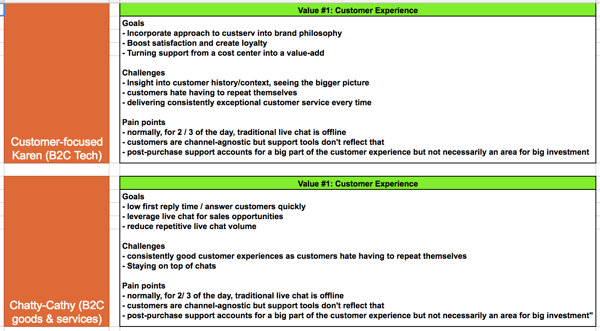
After defining these goals, challenges, and pain points it was about coming up with content ideas. This becomes significantly easier when you know what they’re challenged with or what they hope to achieve. Then you’re left with piecing it into an editorial calendar and assigning each piece to internal contributors and the roster of freelance writers you’ve built.
Success is more than an editorial calendar
I’d set goals I wanted to achieve in the final quarter of 2017 around MQLs, blog subscribers, and organic traffic. This helped align our offsite marketing efforts.
One of our top goals this quarter was securing top-tier links: 2 x top tier, 3 x tech links, and 5 x blogger links. We hired a PR freelancer, gave him ownership of pitching stories to top tech publications. We had some bites, but nothing came of it. Essentially, his tactic was to go for the top-tier publications and then work down.
Once I’d mapped out our own blog and delegated writing, I could look off-site. With the failures of PR efforts fresh in my mind, I decided to change tactics and work my way up the publication chain starting with customer service bloggers.
I got two guest posts published on customer service influencer blogs, one on Adrian Swinscoe’s and one on Shep Hyken’s. I got a ghostwriter to pen them under each founder’s name and gave her a clear brief on how we wanted to feature the report.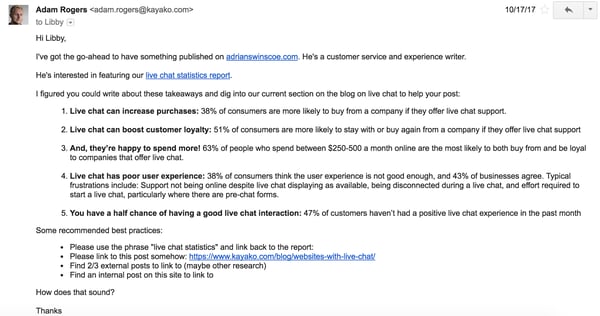
Once our guest post went live on Adrian’s blog and we’d helped promote it I went back to him and asked if Jamie, Kayako’s cofounder, could be a guest on his podcast to discuss the report. A month later, the episode was recorded and then published on iTunes.
Search became a success
I mentioned above that SERP rankings are vital to the formula we have for content success at Kayako. Although the keyword “live chat statistics” doesn’t rank highly on searches per month, we quickly achieved a top 3 rank. Currently, we sit behind INC in second place—and it will take a big backlink campaign to displace them.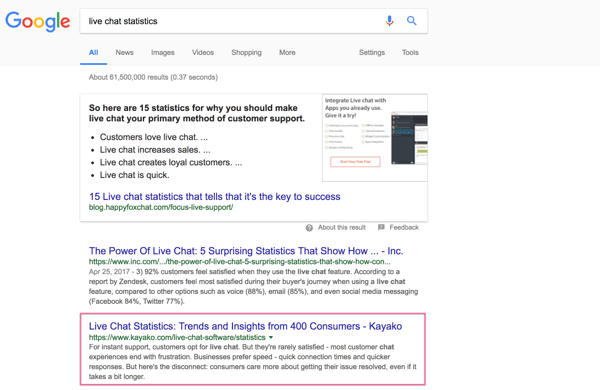
But that was one slice of the pie. The idea was to use the editorial calendar for contextual search domination. As said before, most content is discovered by people who need it, when they need it. This is a content model Jimmy Daly calls the hub-and-spoke strategy and the content strategy I took forward with the live chat messenger campaign.
Here’s a look at our rankings over one week of data collection: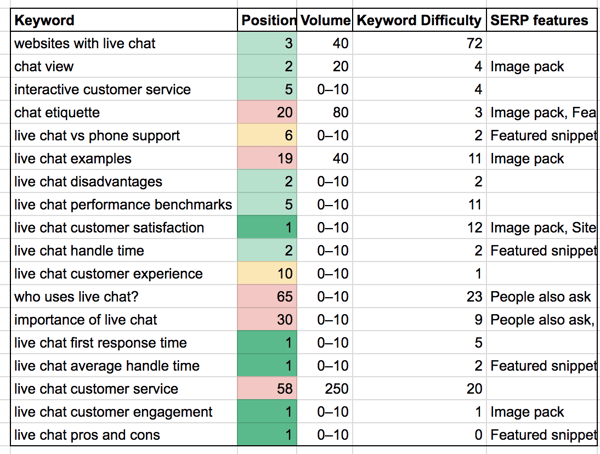
Don’t forget social media
I knew social media wouldn’t be the best acquisition channel for us for this campaign. But we did need an initial spike to help things get off of the ground with this report. These are some actions we took:
- When Kayako Messenger launched on product hunt, we made the first comment drop a link to our industry report.
- Posted a snippet and key takeaways to both GrowthHackers and Inbound.org.
- Hired Nichole Elizabeth DeMeré’s rocket fuel service to keep that initial momentum and traction going. (Note: Any content agency can do this for you. This is a particular area we needed help from a freelancer, as I was leaning into our calendar and heavily involved in writing and editing.)
When one content marketer isn’t enough
While constraints summon the best of your creativity, there is a negative impact they can have on your content. For example, I’m proud of the quality we produce. It takes a lot of effort to get feedback from customers like this:
But I know building out an evergreen content piece takes a lot of resources away from my dedication to the editorial calendar. While I have a process, like using the stock-and-flow system, to produce something like the training guide. I can’t take a month off to work on a new resource.
When you're limited in resources, you have to use specialists where you can.
For long-form guides
You can either write the guide yourself and task freelancers to write content for weekly blog commitments or use a dedicated freelancer that will build you an evergreen resource you’re proud of. Writing a 6000-word guide doesn’t scare me. I’ll lean into the former. But if writing a piece that long terrifies you, go for the latter.
When busy periods wash over
Although the live chat statistics piece was written internally, building and pushing it live was a time when the whole website was being redesigned. New pages were popping up everywhere. Our in-house web developer was up to his neck with a backlog of pages to ship. We hired a freelance web developer to build the stats page because otherwise, it wouldn’t have been live at the same time the new Kayako Messenger hit the market.
Promotional guilt will always hang over your head
In an ideal world, I’d like to commit to a growth calendar that The Atlantic saw huge growth happen on their site. Essentially, you spend as much time on distribution as much as creation.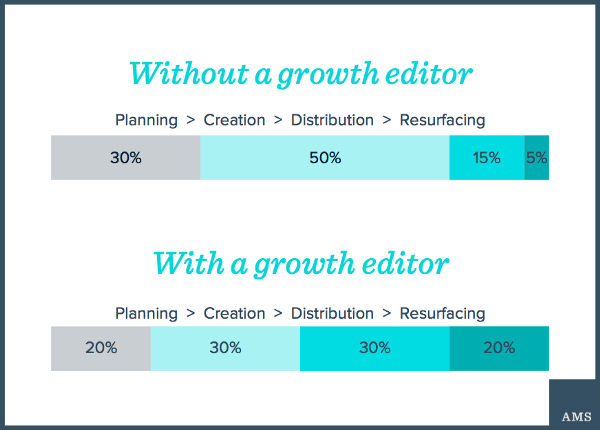
I try to work on promotional aspects like pitching blogs to newsletters, asking for backlinks, or requesting then writing guest posts. When I get drawn into that, my efforts get drawn away from our blog, email list, etc., because a blog post can’t write itself and an email can’t email itself to your list. So then I get drawn back to our blog, but then my resources get taken away from promotion and amplification. In the end, my process looks more like operating without a growth editor than operating with one. It’s a vicious cycle and I hate it, but it’s the reality of being a one-man team.
What happens next?
As a content marketer, you never feel like the work is done. It always feels like there’s so much more to do—and more that you can do. Especially when competition is already high in the field and continues to increase. With Hubspot launching their conversations platform, the customer support content industry is about to get very crowded for me.
My current aim is to publish one article a week and one resource a quarter. But if I ever wanted to move up to two articles a week or build out more evergreen resources then it would take another hire or an agency partnership that works.
____________________________________
About the author: Adam Rogers is the content marketing strategist and editor of the Kayako blog. Adam loves guitars, music, books, and his wife Lacey. You can find him on Twitter.



